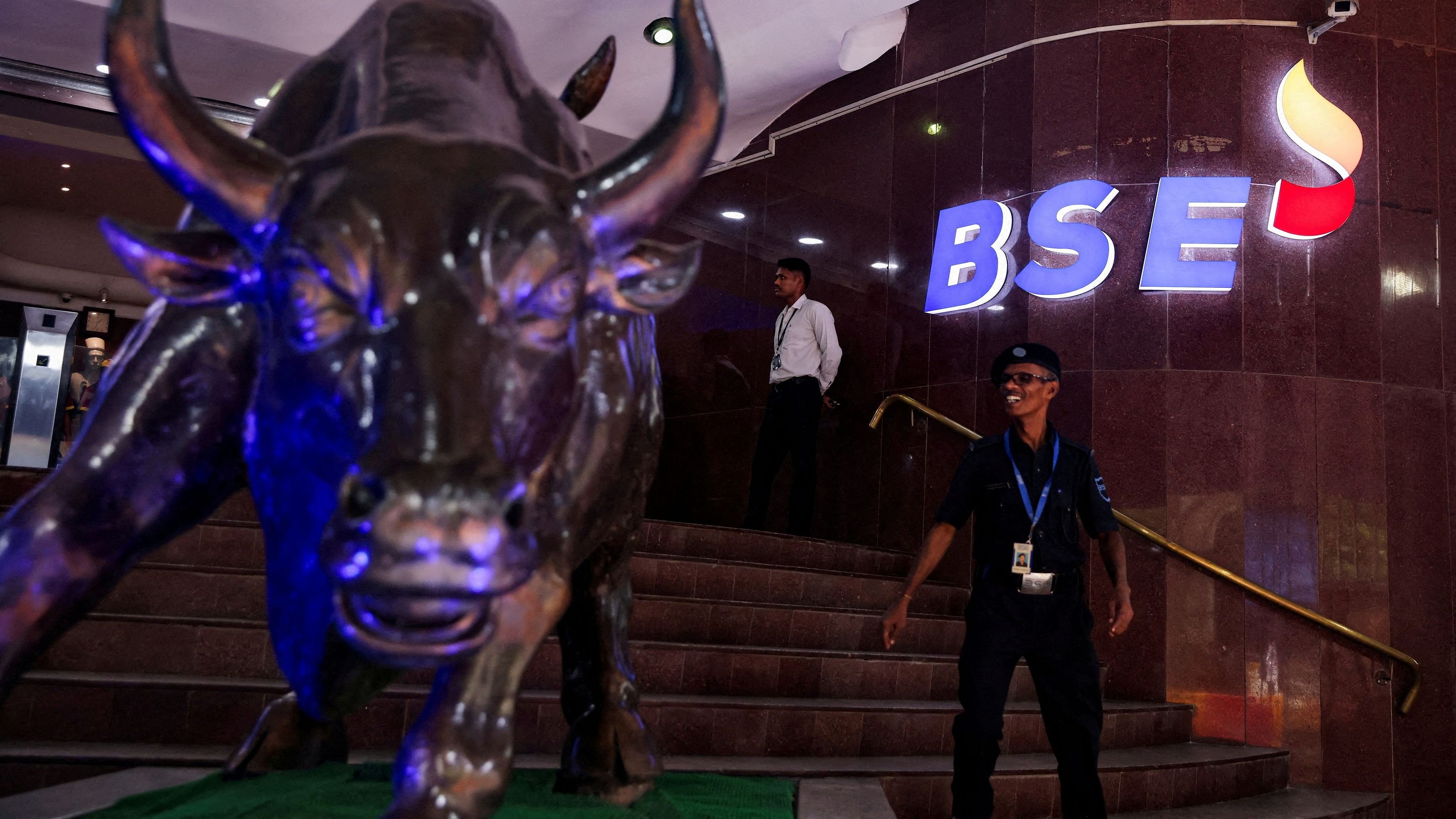
The new logo of the Bombay Stock Exchange (BSE) building is seen in Mumbai.
Credit: Reuters Photo
Anyone wondering whether the India juggernaut is sustainable will find the answer in bonds, which have a penchant for discerning the way of the world and telling every other market what to do.
At least $1 trillion of government securities traded daily in the most populous nation and biggest democracy is poised to become the darling of international investors when India this year joins the benchmark for emerging-market debt compiled by JPMorgan Chase & Co. India's entry following Russia’s exclusion after Vladimir Putin's 2022 invasion of Ukraine (and 2014 seizure of Crimea) and when China's sovereign debt is losing its luster, will make Asia's third-largest economy a beneficiary of as much as $40 billion of inflows during the next 18 months, according to Goldman Sachs Group Inc. How big a deal is that? Consider that foreigners, who are currently prohibited from owning more than 6% of India's sovereign debt, held as little as 0.4% last March, paltry by any measure of major developing countries.
Overseas investors will still have to contend with government policies that benefit from Russia's invasion of Ukraine, especially the purchase of Russian oil at discounted prices. Prime Minister Narendra Modi's government also is leading the expansion of the BRICS (Brazil, Russia, India, China and South Africa), who are committed to countering Western influence, curbing domestic dissent from the press and political opponents, and creating an alternative financial system that is less dependent on the US dollar.
But the prospects for rising demand for India’s debt couldn't come at more propitious moment for the world's No. 5 economy, whose gross domestic product rose 7.6% in the three months to September from a year ago, more than any of the economist estimates compiled by Bloomberg and much greater than the Reserve Bank of India’s projected 6.5%. The robust GDP report means India continues to be the fastest-growing major economy, with Modi's government increasing investment in infrastructure and providing subsidies for companies willing to build new plants across the country. “The sharp upside surprise to the GDP figures is a welcome sign especially as it comes in the backdrop of a broad-based pickup across most non-agricultural sectors,” Upasna Bhardwaj, an economist with Kotak Mahindra Bank Ltd., told Bloomberg News at the end of November.
In 2022 and for the first time in three decades, India was no longer a perennial laggard compared to China, with gross domestic product expanding $266 billion, almost twice the $143 billion increase for its Asian neighbor. India’s economy is anticipated to outpace China for at least the next seven quarters, according to 40 economist estimates compiled by Bloomberg. India also is outperforming Japan and Germany, the third- and fourth-largest economies, to the extent that it will surpass Japan (almost $5 trillion of GDP) by 2027, Michael Patra, the deputy governor of the Reserve Bank of India predicted in October 2022.
All of which is the backdrop for the S&P BSE 500 Index topping the rest of the world when measured against the global emerging-market benchmark for equities last year. The annualized return of publicly traded Indian companies was 16 percentage points greater than the MSCI Emerging Market Index, or roughly twice the average margin of nine and seven percentage points during the past 10 and 20 years, respectively. Indian companies also appreciated at a faster, unprecedented rate relative to their China counterparts, with an annualized advantage of 37 percentage points in 2023, crushing their eight and three percentage-point margins during the past 10 and 20 years, according to data compiled by Bloomberg.
Global investors are so confident in corporate India that they are paying 82% more for its shares than Chinese stocks as measured by earnings before interest, taxes, depreciation and amortization expenses during the past year when Indian companies gained 26% on average. For their part, China shares depreciated 12% on average and emerging-market shares meanwhile rose 15% on average, according to data compiled by Bloomberg.
REC Limited, the Gurugram-based provider of loans and financing products to states, companies for power generation, transmission, renewable energy as well as infrastructure, rallied 286% during the past 12 months, the best return among the world's 35 specialty finance companies. Kaynes Technology India Limited, the Mysore-based maker of electronic components for auto, railway, medical, defense and consumer companies, appreciated 235% during the past 12 months, beating all its 80 major peers globally.
Such exceptional equity returns were signaled last year when rupee-denominated government bonds produced a 7% total return (income plus appreciation adjusted in US dollars), beating all the world benchmarks, with returns between 3.5% and 5.9%. During the past five years, Indian government bonds returned 20%, outperforming Asia (14%), Europe, Middle East and Africa (minus 17%) and the world's local government bonds (9%). India also topped its peers during the past two, five and 10 years, according to data compiled by Bloomberg.
India, to be sure, faces some of the most difficult barriers to long-term prosperity because of its 1.4 billion population, climate change's extreme weather and persistent government price controls that roil global food supplies. But if price fluctuations in the bond market are any indication of investor preference for the best risk-adjusted returns, the 100-day volatility of Indian bonds declined to 3.4% from 16% a decade ago when the value of India securities was less stable than Asia or Europe/Middle East/Africa securities.
That's another way of saying the inclusion of India in the JPMorgan index is the strongest sign yet that it is leading the global growth club.